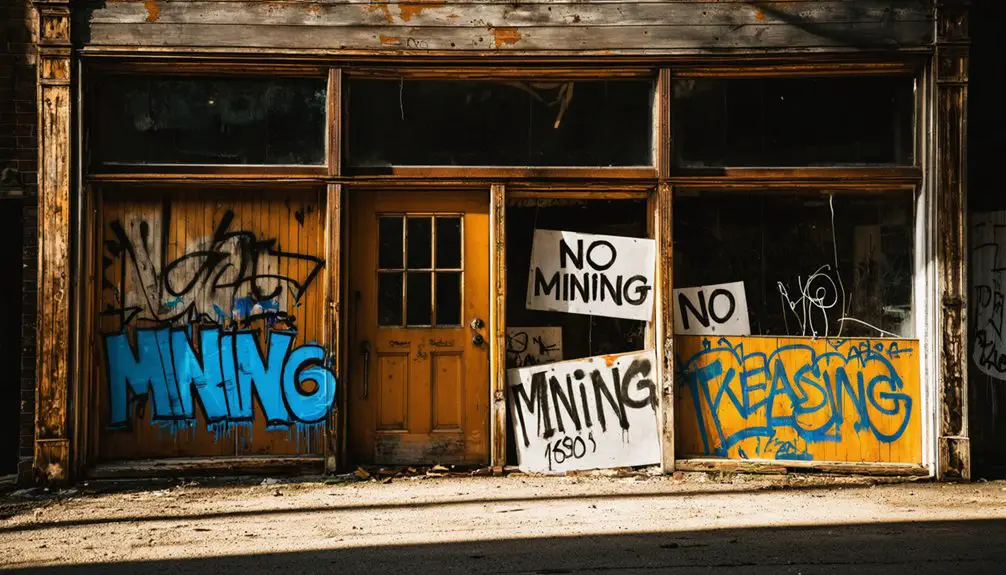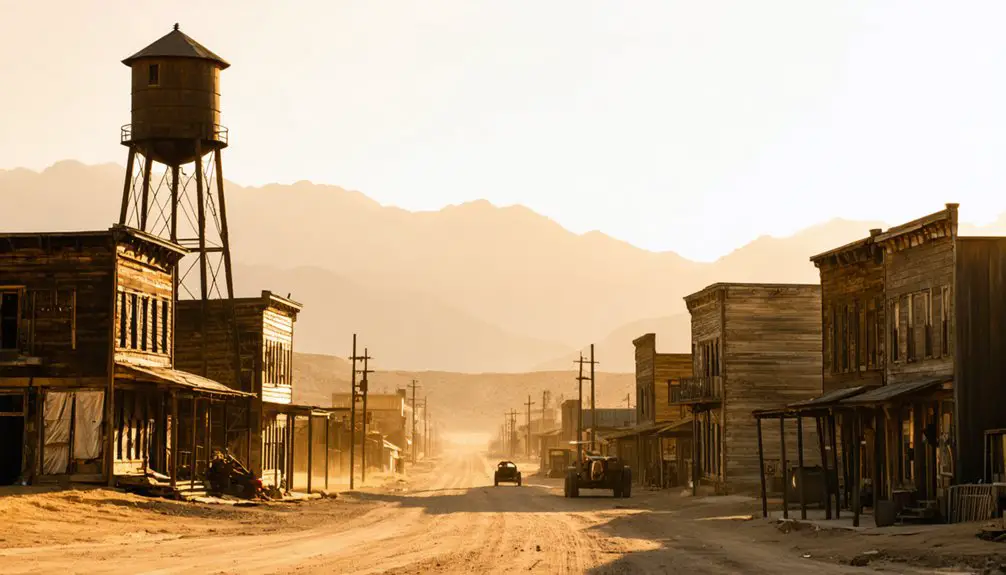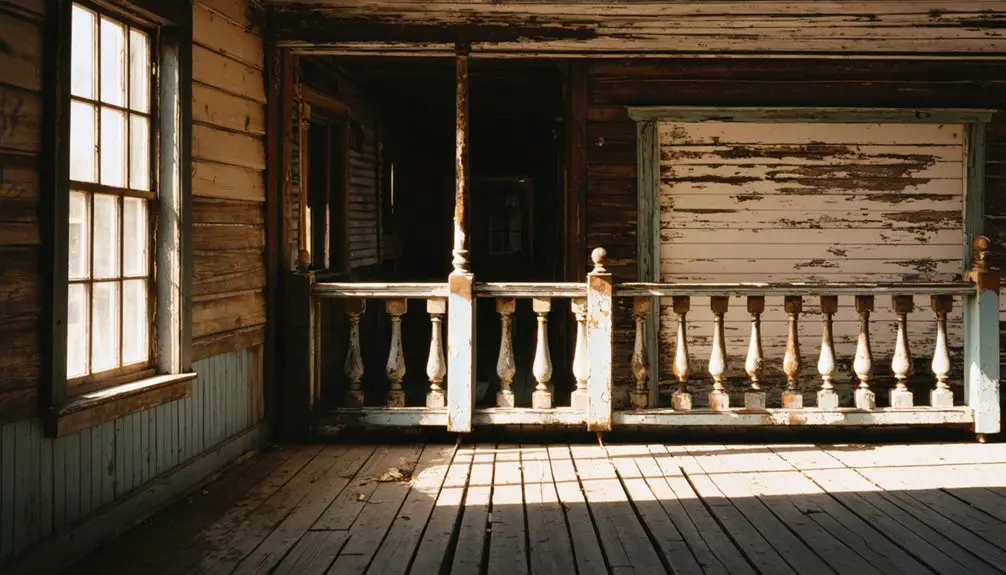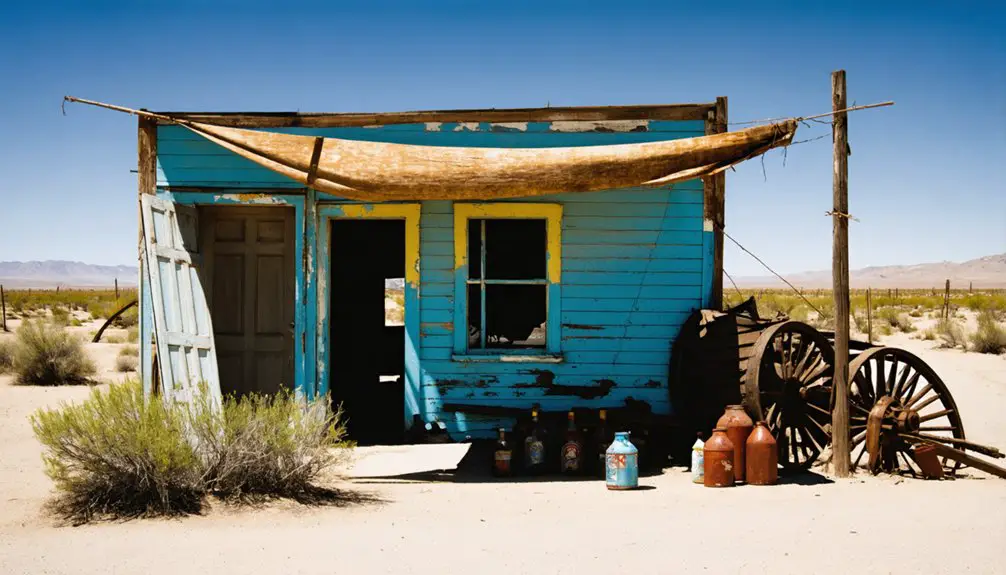You’ll discover a unique ghost town in Nevada, founded in 1916 as the Nevada Cooperative Colony by C.V. Eggleston. This socialist experiment aimed to create America’s “Switzerland,” offering free food and shelter to its stockholder-employees. The colony housed 200 diverse settlers until political tensions over its anti-war stance during WWI led to its abandonment by 1919. Today, its preserved buildings and artifacts tell a fascinating story of ideological ambition in the American West.
Key Takeaways
- Founded in 1916 as Nevada Cooperative Colony, the community began as a socialist experiment but declined by 1919 due to political tensions.
- Originally housed 200 settlers including professionals and families, focusing on cooperative living and sustainable agriculture around Nevada City Hotel.
- Mining operations were central to the economy, with workers laboring from dawn to dusk before operations ceased in 1922.
- Population dwindled to 50 residents by 1880s as gold deposits decreased and the Conrey Placer Mining Company’s operations destroyed original buildings.
- Charles and Sue Bovey preserved the site in the 1950s, relocating frontier buildings and creating an outdoor museum for visitors.
The Rise of a Socialist Dream
While many western communities emerged from mining or railroad development, Nevada City arose from a distinctly different vision in 1916.
You’ll find its origins in the socialist aspirations of C.V. Eggleston, who established the Nevada Cooperative Colony on 1,700 acres near Fallon in Churchill County.
The founders envisioned transforming Nevada into America’s “Switzerland” through their utopian ideals. You’d have discovered ambitious plans for a self-sufficient community complete with hotels, sunken gardens, and modern amenities.
The colony promised its stockholder-employees free food, shelter, and lifetime security. Initial membership fees ranged from hundreds to thousands of dollars. Entertainment wasn’t forgotten either – you could’ve enjoyed vaudeville performances, joined the literary society, or watched motion pictures.
Even children had their own “Kid Kolony” housed in a circus tent, emphasizing communal living from an early age. The community also published its own newspaper called The Cooperative Colonist to keep residents informed.
Life in the Nevada Cooperative Colony
Once you stepped into Nevada City in 1916, you’d have found yourself among a diverse community of 200 settlers, including doctors, politicians, and ministers, all united by their commitment to cooperative ideals.
You’d have witnessed community events centered around the Nevada City Hotel, formerly the Harmon farmhouse, where settlers gathered to discuss their vision of economic fairness and independence.
The colony’s agricultural practices focused on self-sustainability, with local farmers working together rather than competing.
You’d have read about these efforts in The Cooperative Colonist newspaper, which promoted the colony’s progress and attracted new members.
While ambitious plans for sunken gardens, tennis courts, and parks promised a sophisticated lifestyle, daily life revolved around creating a self-sufficient haven away from world conflicts.
Like the resilient spirit shown after the devastating fires of 1856 and 1863, the community demonstrated remarkable determination in building their cooperative society.
New members paid between several hundred dollars to join the community and gain access to free food and shelter.
Political Tensions and Anti-War Stance
As America entered World War I in 1917, you’d have found Nevada City’s socialist ideals directly challenged by the era’s patriotic fervor. The colony’s anti-war stance and resistance to conscription put them at odds with Churchill County authorities, leading to intense political repression.
Nevada City’s anti-war socialist principles collided with wartime patriotism in 1917, sparking fierce government backlash and persecution.
You’ll discover four key developments that sealed the colony’s fate:
- Sheriff Mark Wildes’ violent confrontation with colonist Paul Walters over draft evasion
- Growing hostility from neighboring communities who opposed their socialist ideology
- Internal leadership struggles that weakened the colony’s founding principles
- Replacement of original socialist leaders with more capitalistic management by 1918
The mounting tensions proved insurmountable. What began as a dream of turning Nevada into “the Switzerland of the United States” ended in abandonment, with most families departing by 1919. The location required careful disambiguation of Nevada City to distinguish it from other similarly named places in the region.
Daily Operations and Communal Living
In Nevada City’s mining heyday, you’d find miners working from dawn to dusk while relying on local businesses like the mercantile store and blacksmith for essential supplies and services. Today, these buildings are part of a living historical museum that lets visitors step back in time.
You could witness the strong sense of community through shared facilities, social gatherings at saloons, and entertainment featuring player pianos and theater performances.
Living conditions in the miners’ cabins were basic, with wood stove heating and minimal furnishings, yet the town’s layout fostered a tight-knit atmosphere through its centralized communal spaces and shared amenities. The area produced an incredible 2.5 billion worth of gold before mining operations ceased in 1922.
Work and Resource Distribution
While gold mining dominated Nevada City’s economic landscape, the town’s daily operations relied on an intricate web of work roles and resource distribution systems.
You’ll find that mining techniques evolved from simple panning to sophisticated hydraulic operations, requiring careful resource management and coordination among workers.
The town’s dynamic work structure included:
- Small mining groups working claims along Alder Gulch, sharing equipment and expertise
- Support trades like blacksmiths and carpenters maintaining essential infrastructure
- Merchants operating as significant supply hubs for mining equipment and provisions
- Specialized crews managing water rights and distribution through complex flume systems
During peak seasons, you’d witness miners starting work at dawn, while support businesses aligned their schedules to serve the community’s needs efficiently. Today’s living history events from Memorial Day to Labor Day help demonstrate these daily operations for visitors. Visitors today can explore these operations through preserved structures that showcase the mining community’s daily life.
This intricate system kept Nevada City’s gold operations flowing smoothly.
Social Life and Housing
Life in Nevada City revolved around a vibrant mix of social venues that shaped the community’s daily rhythm, from the bustling activity of three general stores to the camaraderie found in two saloons and the local brewery.
You’d find miners gathering at the Masonic Hall for community meetings, where decisions about local governance took shape. The housing architecture reflected the practical needs of the mining community, with modest wooden cabins clustered near mining operations.
Day-to-day life centered around essential services like blacksmith shops and livery stables. The general stores weren’t just supply points – they served as social hubs where you could catch up on local news while purchasing household goods and mining equipment. The community’s wealth grew rapidly as the region produced thirty to forty million in gold during its first five years.
In these communal spaces, residents forged the bonds that helped them survive the challenges of frontier life.
Local Opposition and Conflict

The Nevada City colony’s strong anti-war stance during World War I drew intense local hostility and marked it as a target for authorities.
You’ll find that tensions reached their peak when Churchill County Sheriff Mark Wildes conducted raids to arrest draft evaders, particularly Paul Walters, leading to violent confrontations.
The colony’s pacifist ideology, combined with widespread pro-war sentiment in Nevada, ultimately contributed to its rapid decline as most families departed by 1919 under mounting social and legal pressures.
Anti-War Stance Backlash
Since the 1970s, Nevada City’s traditional conservative population has clashed with an emerging progressive movement, sparked by an influx of anti-war activists and Bay Area transplants.
You’ll find this cultural resistance manifested through:
- Monthly protests that evolved from nuclear testing opposition into broader anti-war demonstrations near the Nevada Test Site
- Community solidarity among 200+ activist groups establishing Peace Camp as their base of operations
- Regular civil disobedience actions during Holy Week, Mother’s Day, and Hiroshima anniversaries
- Growing tension between established residents and newcomers over political ideologies
The divide deepened as protesters maintained a persistent presence, with over 37,000 participants and 15,000 arrests between 1986-1994.
This ongoing conflict reflects the broader national debate about military activities, environmental concerns, and changing community values in the American West.
Sheriff’s Raid and Arrests
During August 2025, Nevada City experienced a massive law enforcement operation as eight search warrants targeted illegal cannabis activities across multiple properties.
The sheriff’s raid uncovered over 11,498 illegal cannabis plants and nearly 500 pounds of processed cannabis, which authorities promptly destroyed.
You’d have witnessed multiple agencies working together, from the Sheriff’s Special Investigation Unit to California Fish and Wildlife, as they discovered environmental crimes affecting local waterways.
The operation led to several arrests, including two cite-arrests in Nevada City and previous arrests from May involving both cultivation and weapons charges.
Law enforcement seized eleven illegal firearms, highlighting the connection between cannabis operations and armed activity.
The multi-agency response demonstrated authorities’ determination to combat both drug-related and environmental crimes in your historic mining town.
Financial Struggles and Mismanagement
As mining operations in Nevada City expanded rapidly in the mid-1800s, financial instability plagued the town’s development and ultimately contributed to its downfall. The town’s volatile economy, dependent on unpredictable mining yields, led to devastating population decline, with only 100 residents remaining by 1869.
Corporate mismanagement further accelerated Nevada City’s demise through:
- The Conrey Placer Mining Company’s destructive dredging operations (1899-1923) that demolished original buildings
- Overcapitalization and speculative ventures that drained capital from the region
- Inefficient resource management yielding only $10 million from dredging compared to earlier $30-40 million placer finds
- Shifting investor focus to new strikes like Comstock, leaving Nevada City’s economy stagnant
The combination of unstable mining returns and poor financial planning sealed the town’s fate, transforming it from a bustling settlement to a ghost town.
The Final Days of the Colony

While the 1880s marked Nevada City’s terminal decline, the once-thriving mining colony’s transformation into a ghost town unfolded through a series of defining events.
You’d have witnessed the final exodus as the population shrank to just 50 residents, with miners seeking fortune elsewhere, leaving their homes to crumble.
The Conrey Placer Mining Company‘s arrival in 1896 sealed the town’s fate.
For 24 years, their dredging operations tore through the valley, destroying original buildings and reshaping the landscape.
When mining ceased in 1922, you’d have found nothing but abandoned dredges and scattered remnants of community decay.
Later highway construction further fragmented what remained, until Charles Bovey’s 1950s preservation efforts transformed the ghost town into the open-air museum you’ll find today.
What Remains Today
Despite decades of abandonment, Nevada City’s ghost town stands as a remarkably preserved slice of mining history, where you’ll find original structures still housing authentic artifacts from the boom era.
The arid desert climate has naturally preserved the town’s treasures, allowing you to explore a genuine piece of the American West.
When visiting Nevada City today, you’ll discover:
- Well-preserved original buildings containing ghost town artifacts like household items and mining equipment
- Durable structural remains that have withstood harsh desert conditions
- Historic post office and saloon buildings that reflect late 19th-century architecture
- Informative signage and designated pathways to help you navigate safely through the ruins
The town’s remote desert setting enhances its authenticity, making it an ideal destination for those seeking to experience untamed mining heritage firsthand.
Historical Impact and Legacy

You’ll find that Nevada City’s economic decline was hastened by the Civil War‘s pull on resources and manpower, draining the settlement of essential workers and disrupting supply chains.
The town’s ambitious vision of becoming a permanent commercial hub unraveled as gold deposits dwindled and mining operations became less profitable.
These factors, combined with the challenges of frontier isolation, transformed what was once a bustling mining settlement into a ghost town that now serves as a memorial to the boom-and-bust cycle of America’s western expansion.
War’s Role in Decline
Throughout its turbulent history, Nevada City’s decline was inextricably linked to the devastating effects of multiple wars that shaped the American West. The war impact manifested through deep community fragmentation, as conflicts divided residents along political and ideological lines.
You’ll find that several key factors accelerated the town’s downfall:
- Confederate sympathizers during the Civil War drew unwanted military attention, leading to increased federal oversight.
- The colony’s anti-World War I stance resulted in violent confrontations and draft-related deaths.
- Hostile relations with neighboring communities intensified due to the socialist colony’s war opposition.
- Military infrastructure expansion drew resources and population away from Nevada City toward larger installations.
These wartime pressures ultimately proved too severe for the small community to withstand, contributing to its eventual abandonment by 1919.
Economic Vision Unravels
While war pressures severely impacted Nevada City, the unraveling of its economic vision proved equally devastating to the settlement’s survival.
You can trace the colony’s downfall to fundamental flaws in its socialist experiment, where economic aspirations clashed harshly with reality. The Nevada Cooperative Colony‘s directors mismanaged resources and engaged in questionable financial practices, destroying trust among settlers who’d been lured by promises of shared prosperity.
Community failures mounted as the cooperative farming model collapsed under poor planning and insufficient infrastructure.
By 1919, most families had abandoned their dreams of anti-capitalist utopia, leaving behind deteriorating buildings and unused land.
The colony’s rapid demise serves as a stark reminder of the challenges faced by ideological settlements attempting to establish alternative economic systems in America’s western frontier.
Preserving Nevada City’s Story
Despite the ravages of time threatening to erase Nevada City’s rich frontier heritage, the preservation efforts of Charles and Sue Bovey in the late 1950s marked a turning point in saving this historic mining town.
The Boveys’ visionary preservation work in the 1950s rescued Nevada City from vanishing into the shadows of Montana’s frontier past.
Through historical reconstruction and community engagement, they transformed Nevada City into a living outdoor museum that captures the spirit of Montana’s gold rush era.
You’ll discover the remarkable preservation journey through these key initiatives:
- Relocation of over 100 authentic frontier buildings from across Montana
- Establishment of a complete Chinatown district using seven original structures
- Restoration of the Music Hall from Yellowstone, complete with vintage organs
- Creation of immersive educational programs featuring reenactments of miner’s court trials and vigilante justice
Today, you can walk through these carefully preserved buildings and experience firsthand the raw frontier life of the 1860s.
Frequently Asked Questions
What Was the Average Temperature and Climate in Nevada City?
You’ll experience temperature fluctuations between 67°F highs and 45°F lows annually, with climate patterns showing warm, clear summers and cold, wet winters averaging 55-62 inches of yearly precipitation.
Were There Any Notable Archaeological Finds Discovered at the Ghost Town Site?
You’ll be amazed at the archaeological significance revealed through excavated pit-houses, pueblos, and historical artifacts. Ancient baskets, tools, weapons, and graves tell the story of Ancestral Puebloan settlements spanning 16 miles.
Did Any Original Colony Members Return to Visit in Later Years?
You won’t find documented colony visitors or return stories from original settlers. Historical records don’t show evidence of early colonists coming back to their pioneering settlement in later decades.
What Happened to the Colony’s Official Documents and Records?
Ever wonder what secrets vanished with those papers? You’ll find most colony documents were lost during the 1919 receivership, with poor management and wartime pressures destroying chances of document preservation and historical significance.
Were There Any Deaths or Births Recorded During the Colony’s Existence?
You’ll find very limited death records, with only violent incidents noted during WWI conflicts. Birth statistics weren’t officially documented, though families lived there during the colony’s brief 1916-1919 existence.
References
- https://www.legendsofamerica.com/mt-nevadacity/
- https://en.wikipedia.org/wiki/Nevada_City
- https://www.youtube.com/watch?v=xUd2cIYyZKc
- http://www.historichwy49.com/nvcity/nvchist.html
- https://www.nvexpeditions.com/churchill/nevadacity.php
- https://www.thefallonpost.org/article/998
- https://sco.wikipedia.org/wiki/Nevada_City
- https://discover.bklynlibrary.org/item?b=10899064
- https://outerrealmz.com/nevada-city-nevada-a-socialist-experiment/
- https://coloradosghosttowns.com/nevada city montana.html



